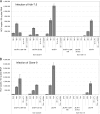Naturally occurring hepatitis C virus subgenomic deletion mutants replicate efficiently in Huh-7 cells and are trans-packaged in vitro to generate infectious defective particles
- PMID: 19587042
- PMCID: PMC2738267
- DOI: 10.1128/JVI.00308-09
Naturally occurring hepatitis C virus subgenomic deletion mutants replicate efficiently in Huh-7 cells and are trans-packaged in vitro to generate infectious defective particles
Abstract
Naturally occurring hepatitis C virus (HCV) subgenomic RNAs have been found in several HCV patients. These subgenomic deletion mutants, mostly lacking the genes encoding envelope glycoproteins, were found in both liver and serum, where their relatively high abundance suggests that they are capable of autonomous replication and can be packaged and secreted in viral particles, presumably harboring the envelope proteins from wild type virus coinfecting the same cell. We recapitulated some of these natural subgenomic deletions in the context of the isolate JFH-1 and confirmed these hypotheses in vitro. In Huh-7.5 cells, these deletion-containing genomes show robust replication and can be efficiently trans-packaged and infect naïve Huh-7.5 cells when cotransfected with the full-length wild-type J6/JFH genome. The genome structure of these natural subgenomic deletion mutants was dissected, and the maintenance of both core and NS2 regions was proven to be significant for efficient replication and trans-packaging. To further explore the requirements needed to achieve trans-complementation, we provided different combinations of structural proteins in trans. Optimal trans-complementation was obtained when fragments of the polyprotein encompassing core to p7 or E1 to NS2 were expressed. Finally, we generated a stable helper cell line, constitutively expressing the structural proteins from core to p7, which efficiently supports trans-complementation of a subgenomic deletion encompassing amino acids 284 to 732. This cell line can produce and be infected by defective particles, thus representing a powerful tool to investigate the life cycle and relevance of natural HCV subgenomic deletion mutants in vivo.
Figures










Similar articles
-
Are trans-complementation systems suitable for hepatitis C virus life cycle studies?J Viral Hepat. 2013 Apr;20(4):225-33. doi: 10.1111/jvh.12069. Epub 2013 Feb 14. J Viral Hepat. 2013. PMID: 23490366 Free PMC article. Review.
-
NS2 is dispensable for efficient assembly of hepatitis C virus-like particles in a bipartite trans-encapsidation system.J Gen Virol. 2014 Nov;95(Pt 11):2427-2441. doi: 10.1099/vir.0.068932-0. Epub 2014 Jul 14. J Gen Virol. 2014. PMID: 25024280 Free PMC article.
-
Efficient trans-encapsidation of hepatitis C virus RNAs into infectious virus-like particles.J Virol. 2008 Jul;82(14):7034-46. doi: 10.1128/JVI.00118-08. Epub 2008 May 14. J Virol. 2008. PMID: 18480457 Free PMC article.
-
Trans-encapsidation of hepatitis C virus subgenomic replicon RNA with viral structure proteins.Biochem Biophys Res Commun. 2008 Jul 4;371(3):446-50. doi: 10.1016/j.bbrc.2008.04.110. Epub 2008 Apr 28. Biochem Biophys Res Commun. 2008. PMID: 18445476
-
A new model to produce infectious hepatitis C virus without the replication requirement.PLoS Pathog. 2011 Apr;7(4):e1001333. doi: 10.1371/journal.ppat.1001333. Epub 2011 Apr 14. PLoS Pathog. 2011. PMID: 21533214 Free PMC article. Review.
Cited by
-
Genetic characterization of hepatitis C virus in long-term RNA replication using Li23 cell culture systems.PLoS One. 2014 Mar 13;9(3):e91156. doi: 10.1371/journal.pone.0091156. eCollection 2014. PLoS One. 2014. PMID: 24625789 Free PMC article.
-
The acidic domain of hepatitis C virus NS4A contributes to RNA replication and virus particle assembly.J Virol. 2011 Feb;85(3):1193-204. doi: 10.1128/JVI.01889-10. Epub 2010 Nov 3. J Virol. 2011. PMID: 21047963 Free PMC article.
-
Are trans-complementation systems suitable for hepatitis C virus life cycle studies?J Viral Hepat. 2013 Apr;20(4):225-33. doi: 10.1111/jvh.12069. Epub 2013 Feb 14. J Viral Hepat. 2013. PMID: 23490366 Free PMC article. Review.
-
Genetic Analysis of Serum-Derived Defective Hepatitis C Virus Genomes Revealed Novel Viral cis Elements for Virus Replication and Assembly.J Virol. 2018 Mar 14;92(7):e02182-17. doi: 10.1128/JVI.02182-17. Print 2018 Apr 1. J Virol. 2018. PMID: 29367245 Free PMC article.
-
Productive homologous and non-homologous recombination of hepatitis C virus in cell culture.PLoS Pathog. 2013 Mar;9(3):e1003228. doi: 10.1371/journal.ppat.1003228. Epub 2013 Mar 28. PLoS Pathog. 2013. PMID: 23555245 Free PMC article.
References
-
- Barazani, Y., J. R. Hiatt, M. J. Tong, and R. W. Busuttil. 2007. Chronic viral hepatitis and hepatocellular carcinoma. World J. Surg. 31:1243-1248. - PubMed

